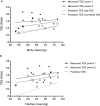High daily energy expenditure of Tuvan nomadic pastoralists living in an extreme cold environment
- PMID: 36418413
- PMCID: PMC9684425
- DOI: 10.1038/s41598-022-23975-3
High daily energy expenditure of Tuvan nomadic pastoralists living in an extreme cold environment
Abstract
Research investigating thermoregulatory energy costs in free-living humans is limited. We determined the total energy expenditure (TEE) of Tuvan pastoralists living in an extreme cold environment and explored the contribution of physical activity and cold-induced thermogenesis. Twelve semi-nomadic pastoralists (47 ± 8 years, 64 ± 8 kg) living under traditional circumstances, in Tuva, south-central Siberia, Russia, were observed during two consecutive 6-day periods in winter. TEE was measured via the doubly labelled water technique. Skin and ambient temperatures, and physical activity were continuously monitored. The outdoor temperature during the observation period was - 27.4 ± 5.4 °C. During the daytime, the participants were exposed to ambient temperatures below 0 °C for 297 ± 131 min/day. The Tuvan pastoralists were more physically active compared to western populations (609 ± 90 min/day of light, moderate, and vigorous physical activity). In addition, TEE was 13.49 ± 1.33 MJ/day (3224 ± 318 kcal/day), which was significantly larger by 17% and 31% than predicted by body mass, and fat-free mass, respectively. Our research suggests the daily cold exposure combined with high levels of physical activity contributed to the elevated TEE. Future research should reconsider the assumption that energy costs due to thermoregulation are negligible in free-living humans.
© 2022. The Author(s).
Conflict of interest statement
The authors declare no competing interests.
Figures






References
Publication types
MeSH terms
LinkOut - more resources
Full Text Sources

